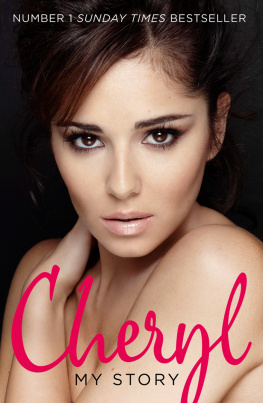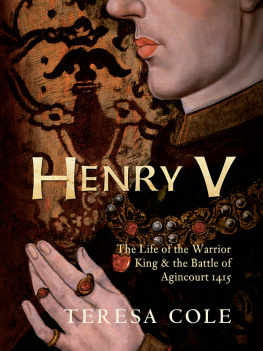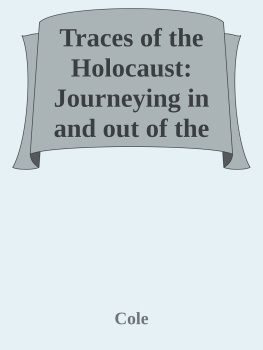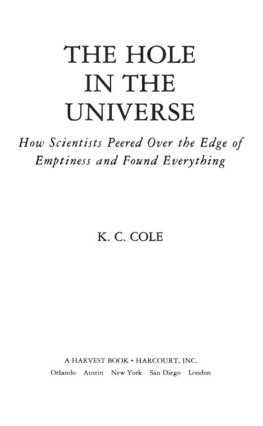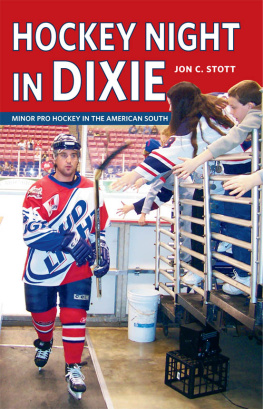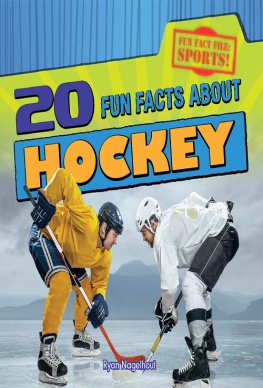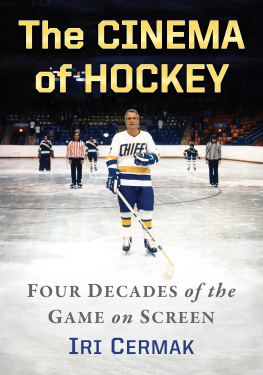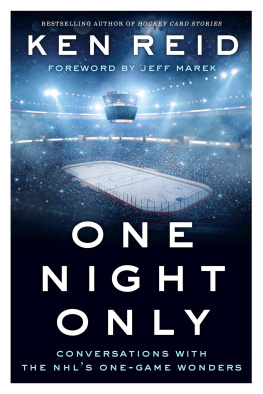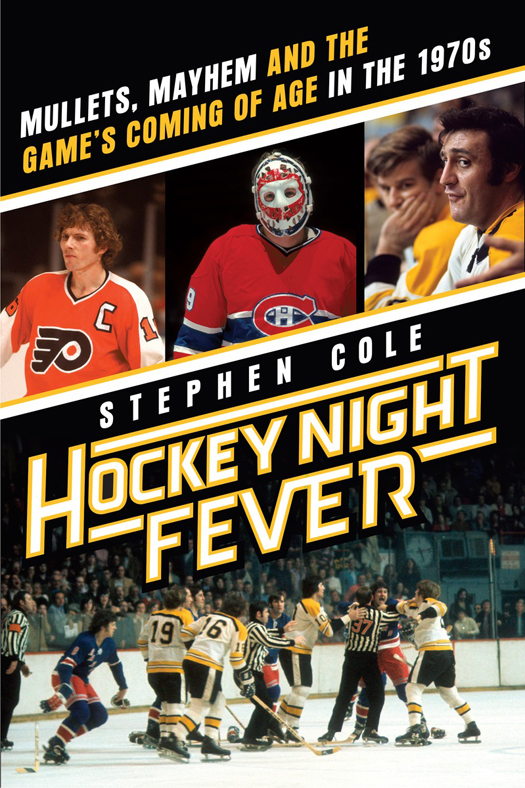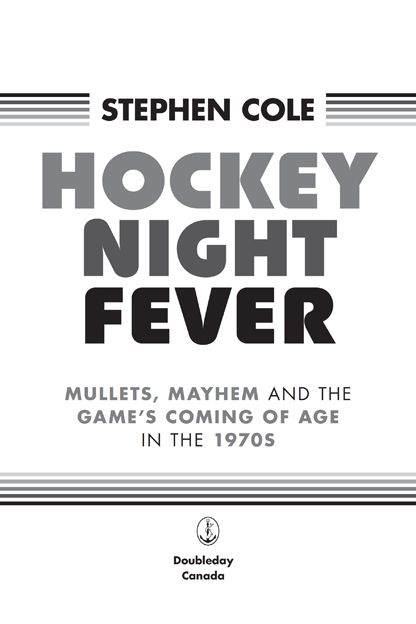also by
STEPHEN COLE
The Canadian Hockey Atlas
The Best of Hockey Night in Canada
Heres Looking at Us: Celebrating 50 Years of CBC-TV
The Last Hurrah: A Celebration of Hockeys Greatest Season 6667
Slapshots: The Best and Worst of 100 Years of Hockey
More Slapshots
Copyright 2015 Stephen Cole
All rights reserved. The use of any part of this publication, reproduced, transmitted in any form or by any means electronic, mechanical, photocopying, recording or otherwise, or stored in a retrieval system without the prior written consent of the publisheror in the case of photocopying or other reprographic copying, license from the Canadian Copyright Licensing Agencyis an infringement of the copyright law.
Doubleday Canada and colophon are registered trademarks of Random House of Canada Limited
Library and Archives Canada Cataloguing in Publication
Cole, Stephen, author
Hockey night fever : mullets, mayhem and the games coming of age / Stephen Cole.
ISBN 978-0-385-68212-1 (bound).ISBN 978-0-385-68213-8 (epub)
1. HockeyHistory. I. Title.
GV846.5.C63 2015 | 796.96209 | C2015-901975-3 |
C2015-901976-1 |
Cover and text design: Andrew Roberts
Cover images: (Bobby Clarke and Ken Dryden) Bruce Bennett Studios; (Phil Esposito) Tony Triolo / Sports Illustrated; (game) Melchior DiGiacomo. All from Getty Images.
Published in Canada by Doubleday Canada,
a division of Random House of Canada Limited,
a Penguin Random House Company
www.penguinrandomhouse.ca
v3.1
To Frank and Frances
Contents
Foreword
Objects in the Rear-View Mirror
Prologue
Lady Byng Died in Boston
PART ONE: TWO-DRINK MINIMUM
Boston Bruins (196576)
PART TWO: CLOCKWORK ORANGE
Philadelphia Flyers (196976)
PART THREE: LES GLORIEUX
Montreal Canadiens (193279)
FOREWORD
OBJECTS IN THE
REAR-VIEW
MIRROR
I f you were there at the time, a bell-bottomed kid living and dying with a favourite National Hockey League team, youll know why a return ticket to the 1970s might be a welcome, thrilling journey. Like, oh boy, turning back the clock and reuniting with your first girlfriend, if only for a little while. Hockey at the time was an astonishing, decade-long surprise party. Bobby Orr, a teenager, one of our tribe, had taken over what was North Americas most conservative, stodgy sport in 1966, changing everything. Soon, a series of big-haired baby boomers, from Brad Park to Guy Lafleur to some kid named Wayne Gretzky, would follow in his jet stream.
And talk about boom! Hockey in the 1970s was as passionate and violent as the music, movies and politics that define the era.
Oh no, more punishing geezer nostalgia, you may be thinking. Some old fart saying everything was better once upon a time. Why should anyone under 40 care about games now decades old? Because it says here that if you truly want to understand and appreciate modern hockey, which I would argue is betterfaster, smarter and more competitivethan ever, you need to understand the sports wild, formative years. If the child is father to the man, the wilful, hungry adolescent is the barely supressed self who still calls the shots when duty calls.
NHL expansion was first contemplated in 1963. The league doubled in size (to 12 teams) in 1967. In coming years, hockey would experience a crazy, difficult-to-predictor fathomgrowth spurt. All the major characteristics of the modern gamethe calculated aggression, furious pace, preoccupation with size and reliance on analyticsarrived in the turbulent, pell-mell 70s.
Thats why its important to understand what happened to hockey at the time, to feel or re-experience the cold-shower shock of all the surprises. The perpetually last-place, presumably doomed Boston Bruins, led by the aforementioned Orr, winning the Stanley Cup in 1970! Two years later, a Russian hockey teammere amateurs, it was saidclobbering NHL all-stars in Montreal. And then, a month later, those same professionals, chastened, bent on revenge, accomplishing something Napoleon never managed: capturing Moscow.
Yes, international hockey, our intermittent obsession, began with a clash of cymbals in the 70s. With a clash of symbols, tooTeam Canada vs. the Soviet Union was advertised as a contest between good and evil. It goes without saying that both sides figured their opponents were the bad guys. Another surprise, although it wouldnt sink in for a while: the country that would benefit most from the collision of hockey-playing nations would be Bobby Orrs adopted homeland, the United States, now the sports youngest superpower.
The good-vs.-evil stuff didnt end with international hockey. Making the battle for NHL supremacythe playoffsan even more potent adventure, two very different NHL superpowers emerged in the mid-70s. Incredibly, the Philadelphia Flyers, a seven-year-old expansion team full of agitated, twitchy bruisersthe Dirty Two Dozen, if you willwon the Stanley Cup in consecutive years before facing the Montreal Canadiens in the 1976 playoff finals. The Habs were seen as standard bearers for old-fashioned hockeythe heroic, gallant Flying Frenchmen. In truth, they too were something new. The Broad Street Bullies, as the Flyers were then and are still known, won by bending the rules and changing how the game was playedbeing more aggressive, playing faster, turning lines over more quickly, than opponents. The Canadiens would succeed by mounting a carefully plotted counterinsurgency, compiling a bigger, faster, younger team than the Flyers.
They turned the game up another notch.
Both teams practised harder than anyone else (except maybe the luckless New York Rangers). Under coach Freddy Shero, the Flyers were the first NHL team to build a weight room and to perform calisthenics on ice. They worked endlessly on a defensive system, memorizing breakout patterns and plays that would become ingrained, automatic. Montreals coach, Scotty Bowman, an obsessive strategist so familiar with performance numberswho did what against certain linesthat he would be nicknamed Rain Man, attacked the Flyers by mixing and matching lines on the fly.
It could be argued that every modern Stanley Cup final is a return to the 1976 HabsFlyers confrontationchess played with explosives.
Seventies hockey remains with us in practice and in spirit. Every January, there is a nationally televised all-star prospects game held in Canada. The countrys best teenagers play for scouts, fans and fun. The coaches are always the same: the True Norths patron saints of shinny, Bobby Orr and Don Cherryboth 70s hockey guys forever. Scotty Bowman remains an advisor to what is the NHLs most successful team, the Chicago Blackhawks. Son Stan Bowman is the general manager.
In some essential ways, 70s hockey never ended. That is why games and players from so long ago remain relevant. Yes, objects in the rear-view mirror are often closer than they seem.


